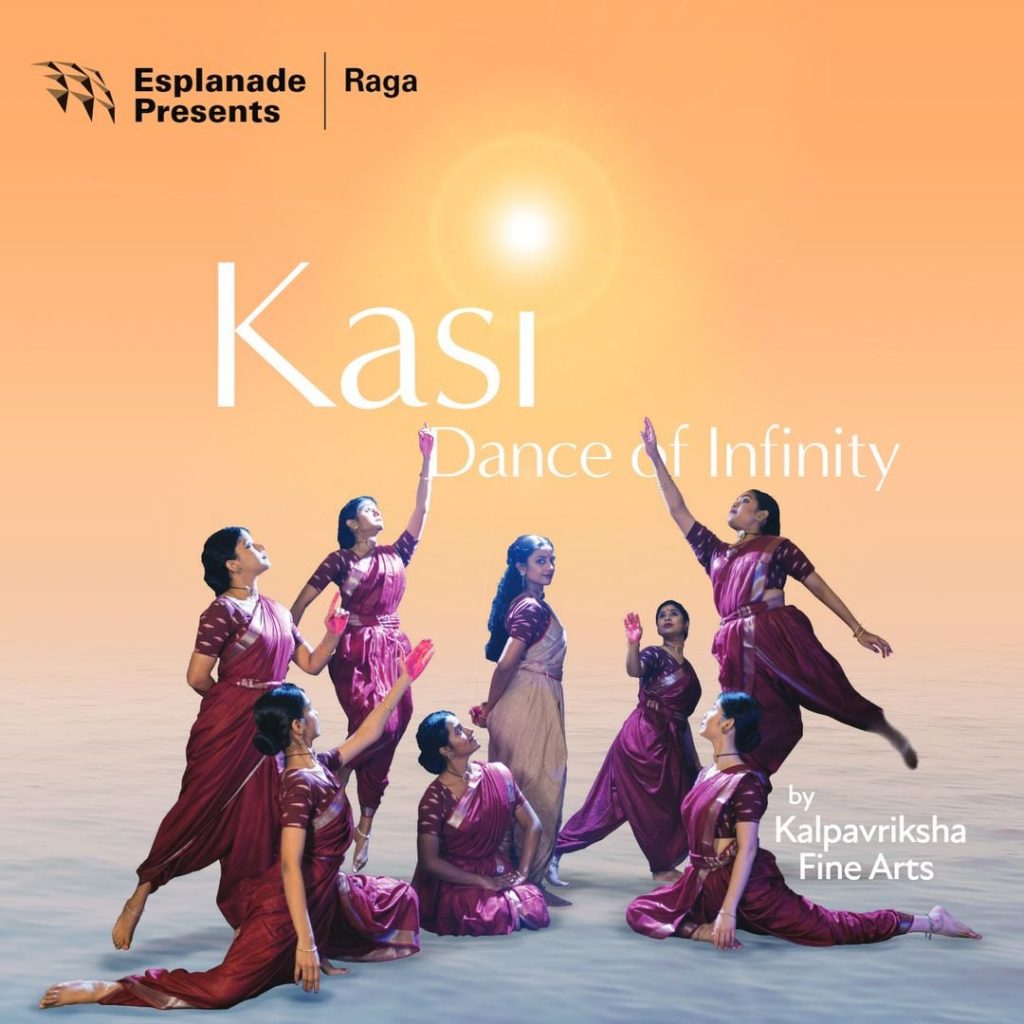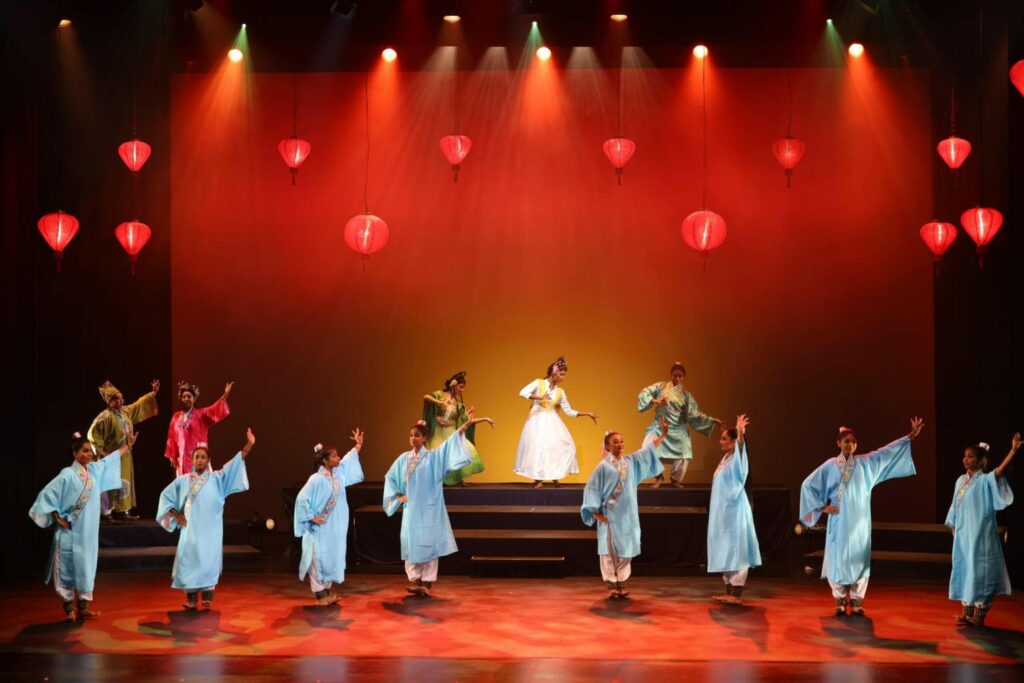Review of KASI

Kasi: A Journey Around & Within Kasi – Dance of Infinity was well-researched, layered and inter-woven in its premise and unfolding, writes Swarnavarsha Gurumoorthy Kasi – Dance of Infinity by Kalpavriksha Fine Arts, presented under Esplanade’s Raaga series is a choreographic work of Meera Balasubramanian under the mentorship initiative as part of Apsaras Arts’s Indian Performing Arts Convention (IPAC) Residency program. Under the guidance of renowned dancer Rama Vaidyanathan, Meera Balasubramanian and her team took the audience through the length and breadth of Kasi, referred to as the spiritual capital of India, letting us journey its vibrant and varied landscape. Divided into four acts, each with a flavour of its own, the production was a celebration of the art of detailing – well-researched and interwoven by Meera, who personified the notion of Kasi. The first act, I am Kasi, opened with the depiction of restlessness within one’s mind, effectively portrayed by the ensemble dancers who broke into a vibrant jathi placing themselves in the formation 8 attempting the establish the idea of infinity. The fluidity in the formations ensured that the varying heights of the supporting dancers were barely significant in the Kasi Panchakam that followed. The second act titled I am Avimukta choreographed with graceful movements glorified goddess Annapurna and her generosity. Act Three began with the process of weaving – thoughtfully conveyed using body movements and adavus with appropriate lighting techniques. To bring in an element of love and union, a Thumri was presented by Meera who wore a purple lehenga like a Kathak dancer, accompanied by the dancers enacting a story of two lovers in the background. This act, I am Benaras ended with Meera presenting a Benaras silk garment that brings a couple (means what?) draws parallels to the rivers, Varun and Asi that unite as Varanasi. The final act, I am Mahasmashaana added vigor after the mellifluous Thumri. The entry was marked by three dancers who moved the audience with their soulful devotion and spiritual ecstasy in a complete trance chanting Kaashikaa-Pura-Adhinaatha-Kaalabhairavam Bhaje. Kalabairava considered the Lord of Kashi, also represents time and breaks the cycle of life and death to attain salvation. A Thillana in ragam Nalinakanthi (composed by Sudha Raghuraman) after that vibrant Kalabairava, offered a different perspective of Kasi with a suggestive depiction of the famous Ganga Aarthi. In an attempt to establish the continuous cycle of time, there were no significant pauses between the acts for the audience to absorb certain aspects of the presentation. The simple aaharya (costume) designed by Meera Balasubramanian and minimalist jewellery not only complemented the mood but also helped the cast execute complex movements with ease. Added to this, the well-seasoned ensemble dancers – Akshaya, Maanasa, Roshini, Preethi, Shobana, Shreya and Soo Mei Fei – maintained high energy levels through the five shows across three days. The musical pieces for the production were carefully chosen from the works of Adi Shankara, Swathi Tirunal, Muthusamy Deekshitar and other eminent composers beautifully arranged and sung soulfully by Delhi-based Sudha Raghuram. One felt that the Thumri could have been handled by a Hindustani singer to add that flavour of a Kathak composition. With Kasi, Meera has established herself as an able choreographer who has the ability to translate her vision, on stage.
Review of Butterfly Lovers

A visual delight but not raising the bar, Swarnavarsha Gurumoorthy breaks down Butterfly Lovers for us… Butterfly Lovers at Victoria theatre, co-presented by Bhaskar’s Arts Academy and Singapore Chinese Cultural Centre was a blend of tradition re-visited almost sixty years since it was first staged. Visualised by Santha Bhaskar in the year 1958 and re-envisaged by her daughter, Meenakshy Bhaskar in 2021, this version combined both the Chinese and Indian dance styles. Dating from the Tang Dynasty, the Butterfly legend talks of Zhu Yingtai and Liang Shanbo, whose relationship is delayed when Zhu cross-dresses as a boy to enter school. This obstacle is removed; Zhu’s father arranges her marriage to a wealthy man. Learning of the news, Liang dies, with Zhu following in suicide. The duo is re-incarnated as loving butterflies. The first act set is a perfect ambience for this Chinese Romeo- Juliet with musician Neil Chua’s soulful performance on the ruan (a Chinese instrument). Within the performance, the set design is also crucial to bring the visual experience to the next level. The stage props such as the traditional Chinese lanterns in a few scenes and dangling creepers in others, successfully created an artistic conception for the audience. Another highlight was the three-dimensional effects in the background that further amplified the scenic beauty. In an effort to blend both styles, the dancers in traditional Chinese attires with salangais, attempted some “Indianized Chinese dance movements” which became repetitive after a point. There were some lively moments during Yingtai’s and Shanbo’s school years along with other scholars which engaged the audience and brought some laughter. Malini Bhaskar as Shanbo and her perfect chemistry with Sarenniya Ramathas as Yingtai reflected extensive years of them dancing together. Their apparent confidence in each other as dancers coupled with pirouettes added dynamism in contrast to the amateur supporting characters and dancers. he scene where Shanbo becomes an alcoholic was thoughtfully planned with only the ruan being played to the viraha portrayed by Malini Bhaskar. The choreography for the Thillana performed by the leading duo seemed to have a lot of packed adavus resulting in some unfinished movements. The musical score for this re-visit is by the renowned music composer Rajkumar Bharathi. This combination of alternating Chinese and Indian music hardly resonated with the theme and was ineffective in creating an emotional impact. The Tamil lyrics and dialogues in the presentation lacked depth in terms of poetry and the choice of words. To sum up, Butterfly Lovers was a delight to watch in terms of aesthetic stage settings, creative visuals and the dynamic lead duo in perfect unison with each other. While Sreejith Krishna’s Don Quixote that premiered in 2015 broke new ground in uniting Indian classical dances with contemporary performance and storytelling elements, this choreographic work of a Young Artist Award recipient missed out on setting high standards. Review is by our young dance-critic-in-the-making, Swarnavarsha Gurumoorthy, recipient of Dr Sunil Kothari Dance Journalism Scholarship by Apsaras Arts. DISCLAIMER: The views and opinions expressed in this review are those of the reviewer and do not represent the views and opinions of Apsaras Arts Ltd. All rights reserved.
Periyachi Roshini Arangetram Review

Periyachi Roshini enthralled the audience with her infectious energy and soulful abhinaya, writes Swarnavarsha Gurumoorthy The Mahatma Gandhi Memorial Hall, Singapore, recently hosted its first-ever performance – Bharatanatyam Arangetram of Periyachi Roshini, student of Singapore Indian Fine Arts Society (SIFAS) under the tutelage of Geethanadhan PK. Saraswathi Sthuthi in ragam Saraswathi set to Rupaka Talam ,composed by the legendary GN Balasubramaniam was an energetic start for the recital which had some innovative adavu patterns in the swarams. This kriti glorifying Goddess Saraswati was set to dance by Geethanadhan who gave the nattuvangam support for the evening. In the Varnam, Adi Sivane in ragam Thodi set to Adi Talam, a composition of the maestro KN Dandayudapani Pillai, Roshini effortlessly played a nayika (heroine) who yearns for the formless Adi Sivan dancing in Chidambaram. The sancharis in the first half were aptly chosen though there could have been a longer teermanam on the mridangam before the start of the second half of the Varnam. The jathi compositions by Kiran R Pai coupled with intricate cross patterns might have been a bit challenging for Geethanadhan on the nattuvangam, but the Varnam was testimony to his confidence and imagination as choreographer. Chinnanchiru Kiliye played by the instrumentalists kept the audience engaged until she Roshini got back on stage with the Padam – Varugalaamo Ayya in ragam Manji set to Misrachapu, a composition of Gopalakrishna Bharati. Narrating the story of Nandanar, an outcast who was denied entry into the Chidambaram temple, Roshini immersed herself in this abhinaya piece choreographed by Neewin Hershall under whom she trained previously. This soulful piece clearly showed her mastery over facial expressions and also created a personal connection with the audience. The fast-paced Keerthanam, Gaana Mazhai in ragamalika set to Rupaka Talamby Ambujam Krishna described the music emanating from Krishna’s flute and the magic it creates. This rare, novel Keerthanam, musically delightful, was choreographed with alternating vivacious movements and a few hurried abhinaya sequences that in hindsight, could have been slower. Roshini’s crowning glory though was the confidence with which she handled this Keerthanam. The dancer then went on to portray a nayika who questions her beloved Lord Krishna who seems a bit indifferent to her in the famous Javali, Parulanna Maata in ragam Kapi set to Adi Talam, a composition by Dharmapuri Subbaraya Iyer. As she performed this choreography of Bragha Bessel, the spontaneous switching between the characters was distinct and flawless. Her attention to detail to effectively depict the characters is highly commendable. Concluding with a Thillana by Patnam Subramanya Iyer in ragam Khamas set to Adi Talam in a the energy with which the piece was choreographed by Geethanadhan showed her command over nritta with neat adavus, controlled leaps and clear finishes. Well balanced stamina, engaging, intriguing adavu patterns and the ease with which Roshini presented her Arangetram, is reflective of her rigorous training along these years under many teachers. The lighting for the evening was well-managed. This being the first performance in the venue, there were sound balancing issues. The impressive orchestra team included T Ramanan on the mridangam who was an asset, accompanied by TP Nishanth (vocal) Niranjan Pandian(flute) and Ganesh Kumar NNR (violin).